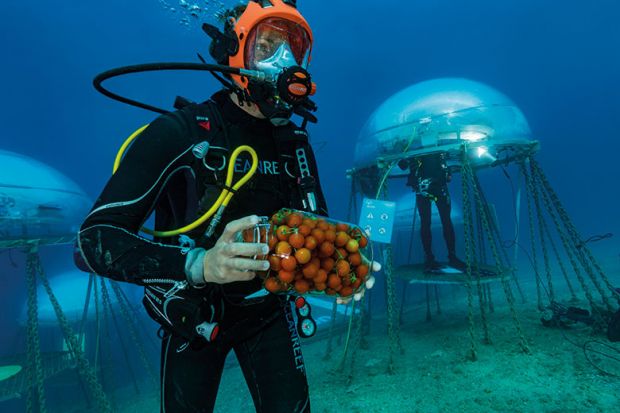This is a book about a hidden side of food, not exactly how it is produced, far less consumed, but about how it is managed “between farm and plate”. It’s a neglected story, but a vital one with huge commercial and social implications.
Robyn Metcalfe is a well-informed commentator, a food historian who has also been a farmer, raising conservation breeds of pigs and cows in the Midwest but finding it hard to get her specialty products accepted by the market. This is partly what prompted her to explore the “farm to plate” aspects of the food industry. The transformation of the food chain from “bites to bytes” is revolutionary, she says, “maybe as revolutionary as the Industrial Revolution”.
A technological optimist, Metcalfe claims that the future food chain will be “smarter, faster and safer” and that feeding cities will become less miraculous and more predictable with food waste increasingly eliminated, “saving resources all along the way”. She sees ancient systems of signed ledgers entering a new era with companies such as IBM and Walmart and Tsinghua University in China collaborating to produce new “blockchain” tracking systems.
She notes enthusiastically that Amazon has filed a patent for underwater storage facilities that she thinks might just be the ideal solution “for cold-chain storage” – and that there are plans being filed for drones and airborne hubs. Companies such as Walmart and Amazon are already obtaining permission to enter homes in order to leave food in the fridge. Last year, Amazon “paid billions” for RING, “a smart doorbell company”.
There’s even a Chinese start-up called GoGo Chicken which uses facial recognition to track each chicken it is transporting “from henhouse to your house”. Each chicken wears a tracking device that transmits the unfortunate animal’s (“your drumstick”) movements to the customer’s cellphone. This is all very significant to Metcalfe, as she sees a world coming in which “apps” link household kitchens to local meat producers “who show you the exact chicken you’ll be dining on that night”.
She recalls that, not so very long ago, it was railways and shipping containers that were revolutionising food chains: “By the end of the 1800s, companies such as General Mills, Nestlé and Campbell’s Soup Company represented the emergence of what we call ‘Big Food’.” The Second World War necessitated additional steps for both producing and distributing food at scale.
If trucking “may seem outmoded” today, in reality it is innovating faster than its competitors. Similarly, ships and even canals continue to be highly cost-effective, which is why fish may be caught in waters off the US, for the US market – but processed in Asia. Airfreight, by contrast, costs about 15 times as much to move – and you’d need a train 80 miles long to move as much as a typical container ship.
In general, Metcalfe sees a high-tech future as holding real promise: “Imagine a [square] metre of soil with its own pesticide and irrigation. The mass treatment of land leading to runoff and waste could be eliminated.” But this does not seem to follow at all. A field would presumably still need treating as a whole and rain would still presumably wash the residues into the rivers.
Occasionally, Metcalfe’s praise for work carried out in these areas at the Massachusetts Institute of Technology sits uncomfortably in a book published by the same university, even if she allows that not everyone in the agricultural community is “wild about MIT’s approach to reinventing the food system”.
Indeed, not everyone is wild about scientists creating meat-like proteins to replace animals, or genetically designed oranges ready to flourish in chilly Alaska, or even bread that is “completely gluten free”. And Metcalfe is right to recall that the industrialisation of food in the 20th century brought with it increased reliance on “synthetic chemicals and artificial flavors”.
Having myself surveyed philosophical attitudes towards food, I know that most philosophers lean towards nostalgic visions of rurality, and away from modern technological solutions. But not all of them. Nietzsche embraced scientific foods, even to the extent of wrecking his own health, and Sartre famously preferred tinned produce to the “real thing”, precisely for being “man-made” as opposed to natural. Yet sometimes Metcalfe’s enthusiasm for the coming food revolution and her jokes about the dying agricultural system come across a bit like a funeral director showing off an ingeniously embalmed corpse.
Metcalfe offers a refreshingly disdainful view of “food evangelists” such as Michael Pollan, saying that they want minimally processed food, made close by, but fail to appreciate that even grinding barley or washing salad is “food processing”. The truth, she explains earnestly, is that “ingredients we need to consume for our health often taste bad or have a yucky feel in our mouths so food scientists have come along to enhance healthy food to make it palatable”. Now that’s evangelism! As is the claim that “more and more, we’ll see processed food and packaging that will bring us fresher, healthier prepared food at lower costs”. But we can still grow a few things locally – to “top our prepared meals”.
The future Metcalfe envisages is one in which “disruptions in the food supply chain will be mitigated by new digital routing software that integrates artificial intelligence” – software that will even be able to “leverage quantum computers” to model all possible scenarios.
Personally, I think there is a bit too much technological optimism here. After all, quantum computing is a speculative technology that defies existing concepts of logic as it works with particles that can take on the value 0 or 1 or both simultaneously – but only as long as they are not measured. It’s a confusing theory and, if that’s the future of food, I’m going to start stocking up on baked beans.
Nonetheless, it seems that in 2017, for example, investors cheerfully “poured more than $1.5 billion into technology-infused solutions for agriculture”, for things such as soil sensors and driverless tractors. Drones and robots are coming too, argues Metcalfe enthusiastically.
“Personalized food based on genetic databases and AI will enable…communities to bring their personal preferences along with them through a facial recognition tool,” she adds. Such changes will be faster without the “baggage of union bargaining”. Meanwhile, “We’re bringing food back into our cities, bit by bit, bite by byte, and eventually nibble by nibble,” Metcalfe notes cheekily.
Alas, adulterated food is the price we pay for complex networks. When consumers occasionally wonder about what happens between farms and plates, they imagine the worst – and in some cases the worst has been happening, admits Metcalfe. Recent years have seen contaminated sugar in Egypt, horsemeat in British ready meals and even unfortunate monkeys turning up in dishes, while listeria and E. coli remain the perennial hazards of the industry. Despite this, Metcalfe believes that robots, scanners that use facial recognition, blockchain and sensors will combine to save us.
Even better, soon “companies that sell us food will use our personal health data to push food that our insurance companies and employers want us to eat”. A startup called Habit already produces kits that capture information from DNA and blood samples to propose appropriate foods for you. Such food is now “pharma to table, instead of farm to table”, Metcalfe quips.
Martin Cohen is visiting research fellow in philosophy at the University of Hertfordshire. His book on the sociology of food, I Think, Therefore I Eat, was published in 2018.
Food Routes: Growing Bananas in Iceland and Other Tales from the Logistics of Eating
By Robyn Metcalfe
MIT Press, 208pp, £20.00
ISBN 9780262039659
Published 5 March 2019
The author
Robyn Metcalfe, a lecturer – and director of Food+City – at the University of Texas at Austin, was born in Los Angeles and lived there until the age of 16. She took a bachelor’s degree in American studies at the University of Michigan, which she believes “provided a framework for learning across disciplines, relating ideas from different fields”. Yet it was a subsequent MA and PhD in history at Boston University that supplied “the intellectual framework for my work as a food historian and my focus on food markets and the development of cities over time”.
Alongside the tools of academic analysis, Metcalfe stresses the importance of her practical experience as a farmer in giving her “an appreciation of the complexities of agriculture, especially of raising livestock and working within the food supply chain. There’s nothing more humbling than trying to solve problems within the constraints of agriculture and the limits of the natural cycles of food production.” It is this background that has also enabled her to “question theories and simple solutions to complex problems”.
So which recent developments have turned Metcalfe into what her publisher describes as “a cautious technology optimist”?
“The arrival of big data, faster computer processors and digital networks will be the next optimisers for the food system,” she replies. But although “many of the problems with our food system can be solved with the new optimisers”, this is unlikely to be “without consequences that are not yet understood. Since humans have complicated cultural, emotional and physical connections with food, they may find that technology interferes with the meaning of food in their lives…So caution [is needed to] question the changes as we go forward.”
Matthew Reisz
POSTSCRIPT:
Print headline: From the field to the fridge
Register to continue
Why register?
- Registration is free and only takes a moment
- Once registered, you can read 3 articles a month
- Sign up for our newsletter
Subscribe
Or subscribe for unlimited access to:
- Unlimited access to news, views, insights & reviews
- Digital editions
- Digital access to THE’s university and college rankings analysis
Already registered or a current subscriber? Login








